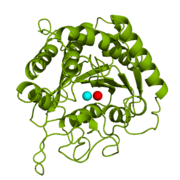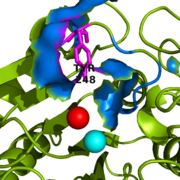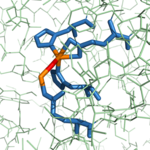Carboxypeptidase A
From Proteopedia
(Difference between revisions)
| Line 19: | Line 19: | ||
=====S1 Subsite===== | =====S1 Subsite===== | ||
| - | In the same way that the S1' subsite is involved in anchoring the polypeptide substrate in place, the <scene name='69/694222/3cpas1subsitespacefill/3'>S1 subsite</scene> (spacefill view, subsite in magenta) contains several residues that help hold the substrate in the active site, but the S1 subsite also contains the residues that are involved in the catalytic chemical mechanism. In general, the residues of the <scene name='69/694222/3cpas1subsitemeshfill/2'>S1 subsite</scene> (pseudo-mesh view, subsite in magenta) have polar or charged side chains that either allow for hydrogen bonding to stabilize negatively charged intermediates of the hydrolysis reaction or position particular atoms appropriately to allow for chemistry to occur. Three residues (<scene name='69/694222/3cpas1subsiteresidues1/3'>Asn144, Arg145, and Tyr248</scene>) aid in the recognition of the C-terminal residue of a polypeptide substrate.<ref name="CPA1" /> The Asn144 and Tyr248 residues each engage in [http://en.wikipedia.org/wiki/Hydrogen_bond hydrogen bonding] and [http://en.wikipedia.org/wiki/Intermolecular_force ion-dipole interactions] with the carboxyl group at the C-terminus, while Arg145 provides additional stability by participating in [http://www.masterorganicchemistry.com/2010/10/01/how-intermolecular-forces-affect-boiling-points/ ion-ion interactions] with the carboxyl group (see Figure 3 in the section titled "Mechanism of Action"). <scene name='69/694222/3cpas1subsiteresidues2/2'>Arg71</scene> helps stabilize the substrate in the active site by engaging in ion-dipole interactions with the carbonyl oxygen of the penultimate substrate residue (Figure 3). Three residues (<scene name='69/694222/3cpas1subsitezn/3'>His196, Glu72, and His69</scene>) are liganded to a catalytic Zn<sup>2+</sup> ion that is complexed to a water molecule positioned one bond distance away from the C-terminal peptide bond carbonyl carbon (Figure 3). This gives the Zn<sup>2+</sup> ion a tetrahedral binding configuration.<ref name="CPA2" /> <scene name='69/694222/3cpas1subsiteglu270/3'>Glu270</scene> deprotonates this water molecule and acts as a base catalyst in the hydrolysis mechanism (Figure 3). <scene name='69/694222/3cpas1subsitearg127/3'>Arg127</scene> and the positively charged Zn<sup>2+</sup> ion help stabilize the negatively charged intermediate generated in the [http://www.masterorganicchemistry.com/tips/addition-elimination/ addition-elimination] hydrolysis reaction (Figure 3).<ref name="CPA2" /> | + | In the same way that the S1' subsite is involved in anchoring the polypeptide substrate in place, the <scene name='69/694222/3cpas1subsitespacefill/3'>S1 subsite</scene> (spacefill view, subsite in magenta) contains several residues that help hold the substrate in the active site, but the S1 subsite also contains the residues that are involved in the catalytic chemical mechanism. In general, the residues of the <scene name='69/694222/3cpas1subsitemeshfill/2'>S1 subsite</scene> (pseudo-mesh view, subsite in magenta) have polar or charged side chains that either allow for hydrogen bonding to stabilize negatively charged intermediates of the hydrolysis reaction or position particular atoms appropriately to allow for chemistry to occur. Three residues (<scene name='69/694222/3cpas1subsiteresidues1/3'>Asn144, Arg145, and Tyr248</scene>) aid in the recognition of the C-terminal residue of a polypeptide substrate.<ref name="CPA1" /> The Asn144 and Tyr248 residues each engage in [http://en.wikipedia.org/wiki/Hydrogen_bond hydrogen bonding] and [http://en.wikipedia.org/wiki/Intermolecular_force ion-dipole interactions] with the carboxyl group at the C-terminus of the peptide substrate, while Arg145 provides additional stability by participating in [http://www.masterorganicchemistry.com/2010/10/01/how-intermolecular-forces-affect-boiling-points/ ion-ion interactions] with the carboxyl group (see Figure 3 in the section titled "Mechanism of Action"). <scene name='69/694222/3cpas1subsiteresidues2/2'>Arg71</scene> helps stabilize the substrate in the active site by engaging in ion-dipole interactions with the carbonyl oxygen of the penultimate substrate residue (Figure 3). Three residues (<scene name='69/694222/3cpas1subsitezn/3'>His196, Glu72, and His69</scene>) are liganded to a catalytic Zn<sup>2+</sup> ion that is complexed to a water molecule positioned one bond distance away from the C-terminal peptide bond carbonyl carbon (Figure 3). This gives the Zn<sup>2+</sup> ion a tetrahedral binding configuration.<ref name="CPA2" /> <scene name='69/694222/3cpas1subsiteglu270/3'>Glu270</scene> deprotonates this water molecule and acts as a base catalyst in the hydrolysis mechanism (Figure 3). <scene name='69/694222/3cpas1subsitearg127/3'>Arg127</scene> and the positively charged Zn<sup>2+</sup> ion help stabilize the negatively charged intermediate generated in the [http://www.masterorganicchemistry.com/tips/addition-elimination/ addition-elimination] hydrolysis reaction (Figure 3).<ref name="CPA2" /> |
=====Putting It All Together===== | =====Putting It All Together===== | ||
Revision as of 19:38, 27 November 2017
| This Sandbox is Reserved from 02/09/2015, through 05/31/2016 for use in the course "CH462: Biochemistry 2" taught by Geoffrey C. Hoops at the Butler University. This reservation includes Sandbox Reserved 1051 through Sandbox Reserved 1080. |
To get started:
More help: Help:Editing |
Carboxypeptidase A in Bos taurus
| |||||||||||
References
- ↑ 1.00 1.01 1.02 1.03 1.04 1.05 1.06 1.07 1.08 1.09 1.10 1.11 Bukrinsky JT, Bjerrum MJ, Kadziola A. 1998. Native carboxypeptidase A in a new crystal environment reveals a different conformation of the important tyrosine 248. Biochemistry. 37(47):16555-16564. DOI: 10.1021/bi981678i
- ↑ 2.0 2.1 2.2 2.3 2.4 2.5 2.6 Christianson DW, Lipscomb WN. 1989. Carboxypeptidase A. Acc. Chem. Res. 22:62-69.
- ↑ Suh J, Cho W, Chung S. 1985. Carboxypeptidase A-catalyzed hydrolysis of α-(acylamino)cinnamoyl derivatives of L-β-phenyllactate and L-phenylalaninate: evidence for acyl-enzyme intermediates. J. Am. Chem. Soc. 107:4530-4535. DOI: 10.1021/ja00301a025
- ↑ Hirose, J., Noji, M., Kidani, Y., Wilkins, R. 1985. Interaction of zinc ions with arsanilazotyrosine-248 carboxypeptidase A.Biochemistry. 24(14):3495-3502. DOI:10.1021/bi00335a016
- ↑ Geoghegan, KF, Galdes, A, Martinelli, RA, Holmquist, B, Auld, DS, Vallee, BL. 1983. Cryospectroscopy of intermediates in the mechanism of carboxypeptidase A. Biochem. 22(9):2255-2262. DOI: 10.1021/bi00278a031
- ↑ Kaplan, AP, Bartlett, PA. 1991. Synthesis and evaluation of an inhibitor of carboxypeptidase A with a Ki value in the femtomolar range. Biochem. 30(33):8165-8170. PMID: 1868091
- ↑ Worthington, K., Worthington, V. 1993. Worthington Enzyme Manual: Enzymes and Related Biochemicals. Freehold (NJ): Worthington Biochemical Corporation; [2011; accessed March 28, 2017]. Carboxypeptidase A. http://www.worthington-biochem.com/COA/
- ↑ Pitout, MJ, Nel, W. 1969. The inhibitory effect of ochratoxin a on bovine carboxypeptidase a in vitro. Biochem. Pharma. 18(8):1837-1843. DOI: 0.1016/0006-2952(69)90279-2
- ↑ Normant, E, Martres, MP, Schwartz, JC, Gros, C. 1995. Purification, cDNA cloning, functional expression, and characterization of a 26-kDa endogenous mammalian carboxypeptidase inhibitor. Proc. Natl. Acad. Sci. 92(26):12225-12229. PMCID: PMC40329
Student Contributors
- Thomas Baldwin
- Michael Melbardis
- Clay Schnell
Proteopedia Page Contributors and Editors (what is this?)
Michael Melbardis, Douglas Schnell, Thomas Baldwin, Geoffrey C. Hoops, Michal Harel




